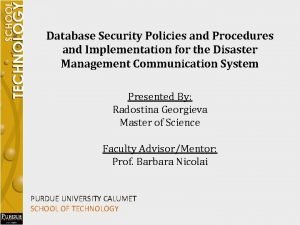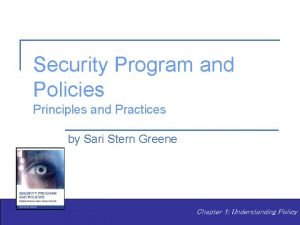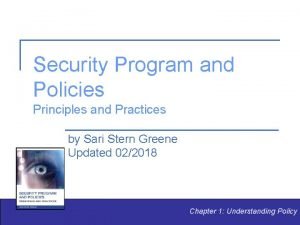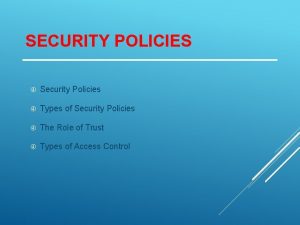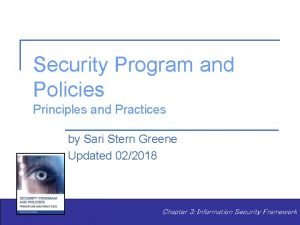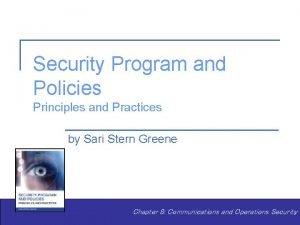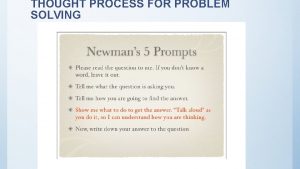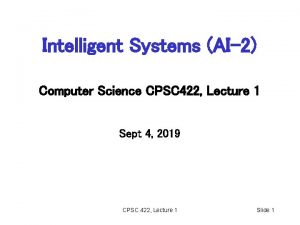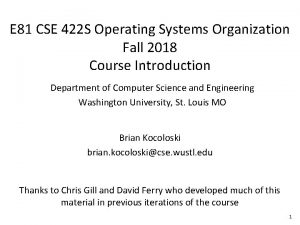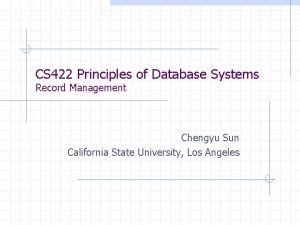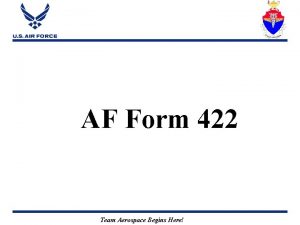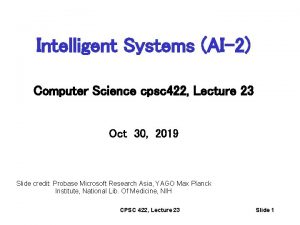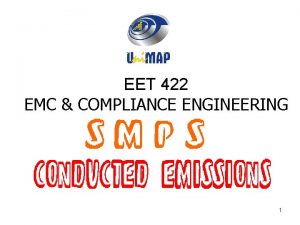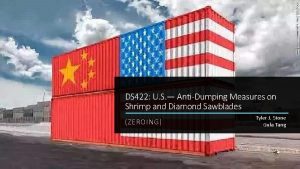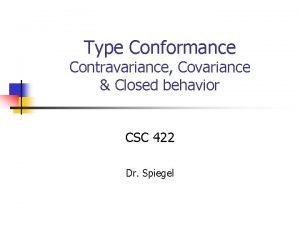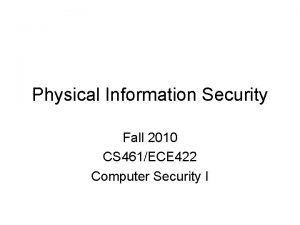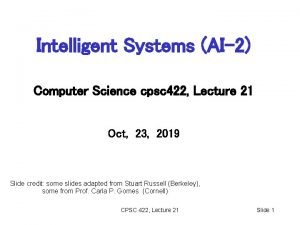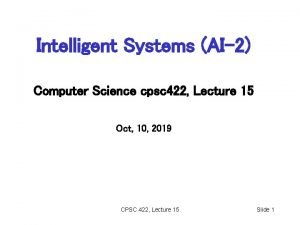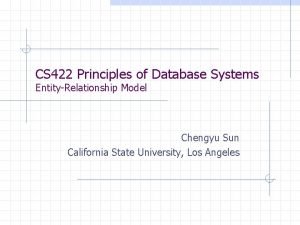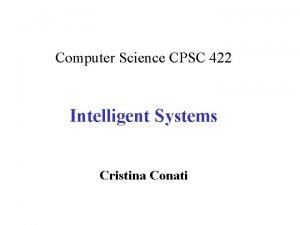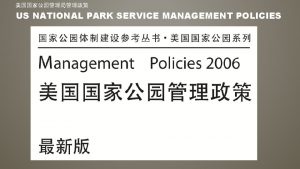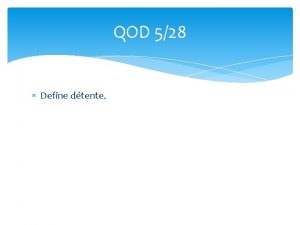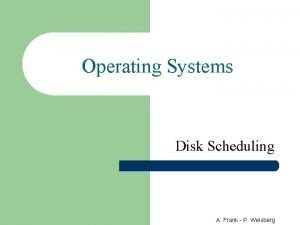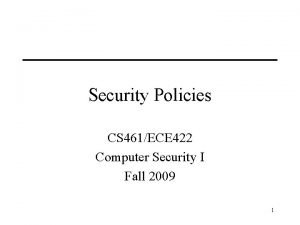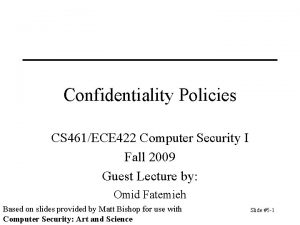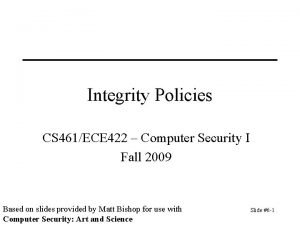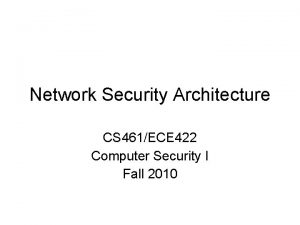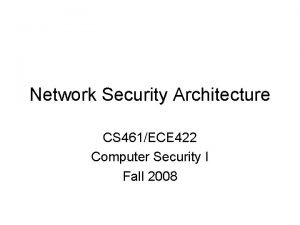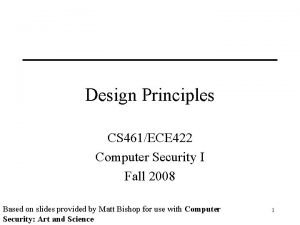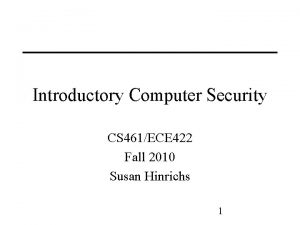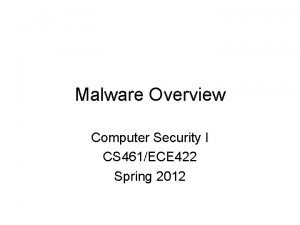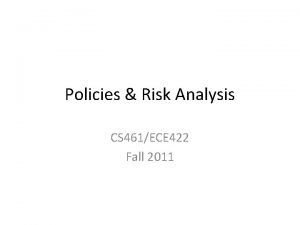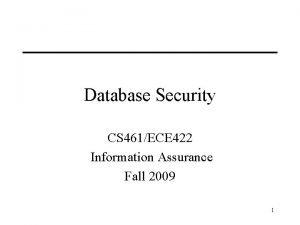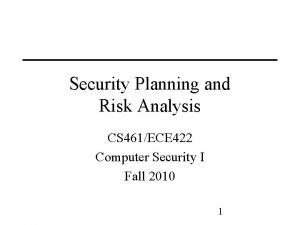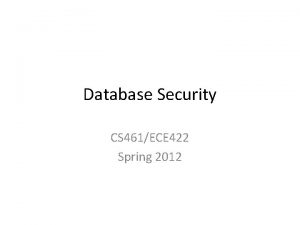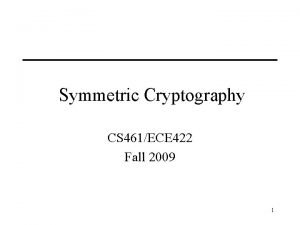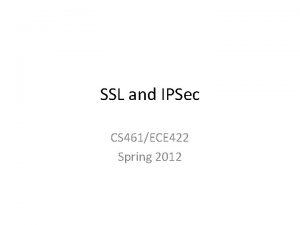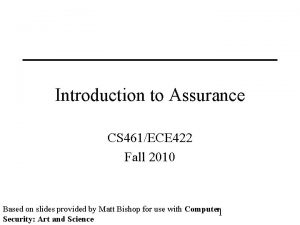Security Policies CS 461ECE 422 Computer Security I




































- Slides: 36

Security Policies CS 461/ECE 422 Computer Security I Fall 2010 1

Overview • Natural language policies – Example policies • Implementation policies – High level – Low level 2

Reading Material • Computer Security, – Introduction – Chapter 1. 3 and 1. 4 • – Security Policies – Chapter 4 skipping 4. 7 SANS policy project – http: //www. sans. org/resources/policies/ • Information Security Policies and Procedures, Thomas Peltier 3

Motivation • Security Policies guides implementation – Reflects what one can assume about an organization – Who has access to which resources in what manner – Confidentiality, integrity, availability • Policy occurs at multiple levels – Policy-driven management 4

Security Policy • Policy partitions system states into: – Authorized (secure) • These are states the system can enter – Unauthorized (nonsecure) • If the system enters any of these states, it’s a security violation – Same state may be secure in one organization and nonsecure in another • Secure system – Starts in authorized state, and never enters 5 unauthorized state

Authorized System States 6

Question • Policy disallows cheating – Includes copying homework, with or without permission • • CS class has students do homework on computer Anne forgets to read-protect her homework file Bill copies it Who cheated? – Anne, Bill, or both? 7

Answer Part 1 • Bill cheated – Policy forbids copying homework assignment – Bill did it – System entered unauthorized state (Bill having a copy of Anne’s assignment) • If not explicit in computer security policy, certainly implicit – Not credible that a unit of the university allows something that the university as a whole forbids, unless the unit explicitly says so 8

Answer Part #2 • Anne didn’t protect her homework – Not required by security policy • She didn’t breach security • If policy said students had to read-protect homework files, then Anne did breach security – She didn’t do this 9

Mechanisms/Controls • Entity or procedure that enforces some part of the security policy – Access controls (like bits to prevent someone from reading a homework file) – Disallowing people from bringing CDs and floppy disks into a computer facility to control what is placed on systems 10

Hierarchy of Policies Organizational Policy Department Standards Linux Lab Umask settings CSIL-Linux 10 SE Linux Policy 11

Types of Policies that Affect Information Security • • • Data protection Privacy Email Hiring Numerous others types of organizational policies with varying impact on information security 12

Natural Language Security Policies • Targeting Humans – Written at different levels • • To inform end users To inform lawyers To inform technicians Users, owners, beneficiaries (customers) • As with all policies, should define purpose not mechanism – May have additional documents that define how policy maps to mechanism • Should be enduring – Don't want to update with each change to technology • Shows due diligence on part of the organization 13

How to Write a Policy • Understand your environment – Risk Analysis (see next lecture) • Understand your industry – Look for “standards” from similar companies – Leverage others wisdom – Already proven with auditors/regulators • Gather the right set of people – Technical experts, person ultimately responsible, person who can make it happen – Not just the security policy “expert” 14

Security Policy Contents • Purpose – Why are we trying to secure things • Identify protected resources • Who is responsible for protecting – What kind of protection? Degree but probably not precise mechanism. • Cover all cases • Realistic 15

University of Illinois Information Security Policies • University of Illinois Information Security Policies – System wide policy; Identifies what, not how – http: //www. obfs. uillinois. edu/cms/one. aspx? page. Id=914 038 • CITES UIUC standards and guidelines – DNS - http: //www. cites. uiuc. edu/dns/standards. html – FERPA - http: //www. cites. uiuc. edu/edtech/development_aids/ferpa /index. html • CS Department policies – https: //agora. cs. illinois. edu/display/tsg/Policies 16

Example Privacy policies • Busey Bank - http: //busey. com/ – Financial Privacy Policy • Targets handling of personal non-public data • Clarifies what data is protected • Who the data is shared with 17

Poorly Written Policies • Cars. gov – Had following in click-through policy for dealers • This application provides access to the [Department of Transportation] Do. T CARS system. When logged on to the CARS system, your computer is considered a Federal computer system and is the property of the U. S. Government. Any or all uses of this system and all files on this system may be intercepted, monitored, recorded, copied, audited, inspected, and disclosed. . . to authorized CARS, Do. T, and law enforcement personnel, as well as authorized officials of other agencies, both domestic and foreign. • According to EFF – http: //www. eff. org/deeplinks/2009/08/cars -gov-terms-service 18

Example Acceptable Use Policy • IEEE Email Acceptable Use Policy – http: //eleccomm. ieee. org/email-aup. shtml – Inform user of what he can do with IEEE email – Inform user of what IEEE will provide • Does not accept responsibility of actions resulting from user email • Does not guarantee privacy of IEEE computers and networks – Examples of acceptable and unacceptable use 19

Policy Models • Abstract description of a policy or class of policies • Types of policies – Military (governmental) security policy • Policy primarily protecting confidentiality – Commercial security policy • Policy primarily protecting integrity – Confidentiality policy • Policy protecting only confidentiality – Integrity policy • Policy protecting only integrity – Service Level Agreements • Availability agreements 20

Policy Languages • Express security policies in a precise way • A continuum of policy languages – English Policies • May be legally precise. Used as basis for legal action. • May be written imprecisely just to give real users a sense of the policy – High-level languages • Policy constraints expressed abstractly – Low-level languages • Policy constraints expressed in terms of program options, input, or specific characteristics of entities on system 21

High-Level Policy Languages • Constraints expressed independent of enforcement mechanism • Constraints restrict entities, actions • Constraints expressed unambiguously – Requires a precise language, usually a mathematical, logical, or programming-like language • Examples – – – Java constraint language – described in CS: A&S DTEL type enforcement language WS-Policy SAML http: //en. wikipedia. org/wiki/SAML IETF Policy models ftp: //ftp. rfc-editor. org/in-notes/rfc 3585. txt 22

IETF Policy Model • Separate policy decision making from enforcement Formal Policy Enforcement Point (PEP) Policy Decision Point (PDP) 23

DTEL – Domain Type Enforcement Language • Basis: access can be constrained by types • Combines elements of low-level, high-level policy languages – Implementation-level constructs express constraints in terms of language types – Constructs do not express arguments or inputs to specific system commands • Used in Sidewinder firewalls • Details of DTEL in http: //citeseer. ist. psu. edu/cache/papers/cs/16179/http: z. Szz Szwww. cs. ubc. caz. Szspiderz. Szabrodskyz. Szdosez. Szbadger. 95. pdf/badger 96 domain. pdf • Type enforcement policies resurfacing in SE Linux Boebert, Kain 85 24

Example • Goal: users cannot write to system binaries • Subjects in administrative domain can – User must authenticate to enter that domain • Subjects belong to domains: – d_user ordinary users – d_administrative users – d_login for login – d_daemon system daemons 25

Types • Object types: – – – t_sysbin executable system files t_readable files t_writable files t_dte data used by enforcement mechanisms t_generic data generated from user processes • For example, treat these as partitions – In practice, files can be readable and writable; ignore this for the example 26

Domain Representation • Sequence – First component is list of programs that start in the domain – Other components describe rights subject in domain has over objects of a type (crwd->t_writable) means subject can create, read, write, and list (search) any object of type t_writable 27

d_daemon Domain d_daemon = (/sbin/init), (crwd->t_writable), (rd->t_generic, t_readable, t_dte), (rxd->t_sysbin), (auto->d_login); • Compromising subject in d_daemon domain does not enable attacker to alter system files – Subjects here have no write access • When /sbin/init invokes login program, login program transitions into d_login domain 28

d_admin Domain d_admin = (/usr/bin/sh, /usr/bin/csh, /usr/bin/ksh), (crwxd->t_generic), (crwxd->t_readable, t_writable, t_dte, t_sysbin), (sigtstp->d_daemon); • sigtstp allows subjects to suspend processes in d_daemon domain • Admin users use a standard command interpreter 29

d_user Domain d_user = (/usr/bin/sh, /usr/bin/csh, /usr/bin/ksh), (crwxd->t_generic), (rxd->t_sysbin), (crwd->t_writable), (rd->t_readable, t_dte); • No auto component as no user commands transition out of it • Users cannot write to system binaries 30

Low-Level Policy Languages • Set of inputs or arguments to commands – Check or set constraints on system • Low level of abstraction – Need details of system, commands • Can think of as specific configuration languages. Generally very closely tied to an application. • Examples: – Xhost – Unix file system access commands – Tripwire integrity databases 35

Example: X Window System • UNIX X 11 Windowing System • Access to X 11 display controlled by list – List says what hosts allowed, disallowed access xhost +groucho -chico • Connections from host groucho allowed • Connections from host chico not allowed 36

Example: tripwire • File scanner that reports changes to file system and file attributes – tw. config describes what may change /usr/mab/tripwire +gimnpsu 012345678 -a • Check everything but time of last access (“-a”) – Database holds previous values of attributes Kim, Spafford 94 37

Example Database Record /usr/mab/tripwire/README 0. . /. 100600 45763 1 917 10 33242. gt. Pvf. gt. Pv. Y 0. ZD 4 cc 0 Wr 8 i 21 ZKa. I. . LUOr 3. 0 fwo 5: hf 4 e 4. 8 TAqd 0 V 4 ubv ? . . 9 b 3 1 M 4 GX 01 xb. GIX 0 o. Vu. Go 1 h 15 z 3 ? : Y 9 jfa 04 rdz. M 1 q: eqt 1 APg. Hk ? . Eb 9 yo. 2 zk. Eh 1 XKov. X 1: d 0 w. F 0 kf. Av. C ? 1 M 4 GX 01 xb. GIX 2947 jdyrior 38 h 15 z 3 0 • file name, version, bitmask for attributes, mode, inode number, number of links, UID, GID, size, times of creation, last modification, last access, cryptographic checksums 38

Comments • System administrators not expected to edit database to set attributes properly • Checking for changes with tripwire is easy – Just run once to create the database, run again to check • Checking for conformance to policy is harder – Need to either edit database file, or (better) set system up to conform to policy, then run tripwire to construct database 39

Key Points • Policies specify Why – Mechanisms specify How • Range of security policies – From high level and imprecise to formal and precise 40
 Security program and policies principles and practices
Security program and policies principles and practices Database security policies
Database security policies Security program and policies principles and practices
Security program and policies principles and practices Security program and policies principles and practices
Security program and policies principles and practices Types of security policies
Types of security policies Security program and policies principles and practices
Security program and policies principles and practices Security program and policies principles and practices
Security program and policies principles and practices A library has 6 422 music cds stored on 26 shelves
A library has 6 422 music cds stored on 26 shelves Cpsc 422
Cpsc 422 Cse 422
Cse 422 Cs 422
Cs 422 Id4t
Id4t Rounding off hundred thousands
Rounding off hundred thousands 365 rounded to the nearest hundred
365 rounded to the nearest hundred Cpsc 422
Cpsc 422 422
422 Ds 422
Ds 422 Csc 422
Csc 422 Cs 422
Cs 422 Cpsc 422
Cpsc 422 Cpsc 422
Cpsc 422 Cpsc 422
Cpsc 422 Cpsc 422
Cpsc 422 Cs 422
Cs 422 Cristina conati
Cristina conati Security private
Security private Nps management policies
Nps management policies Nixons foreign policies
Nixons foreign policies Crime control policies
Crime control policies What are policies
What are policies Manuel roxas economic policies
Manuel roxas economic policies Disk structure in os
Disk structure in os National policy and legislation related to child health
National policy and legislation related to child health Natalist policies
Natalist policies Monetary and fiscal policy interactions activity 5-5
Monetary and fiscal policy interactions activity 5-5 Youth dependency ratio definition ap human geography
Youth dependency ratio definition ap human geography Fear be conquered
Fear be conquered

